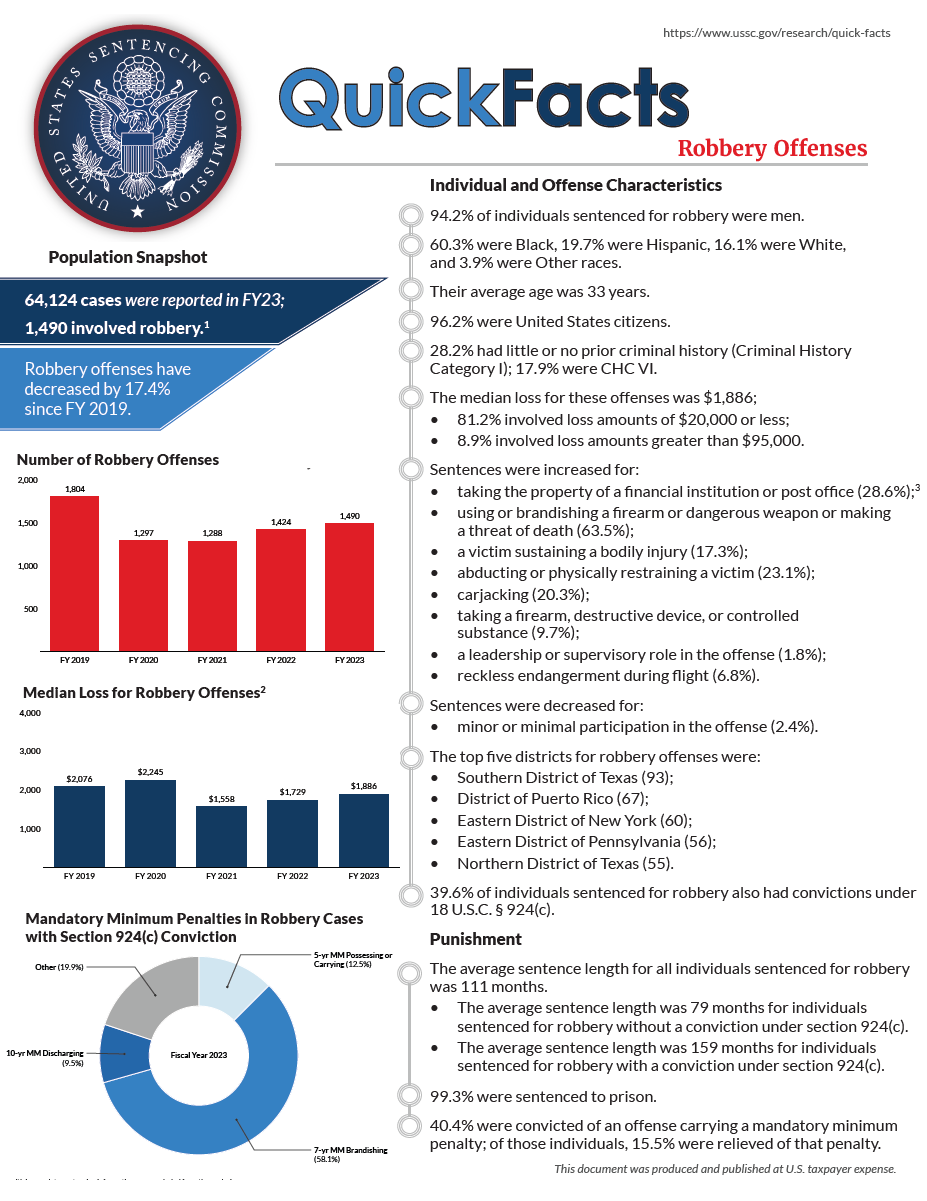Population Snapshot
Of the 61,678 cases reported in fiscal year 2024, 1,305 involved robbery.1 Robbery offenses have increased by 0.6% since fiscal year 2020.2
Click the cover for the PDF handout or learn more below.
Individual and Offense Characteristics
- 94.0% of individuals sentenced for robbery were men.
- 62.5% were Black, 16.9% were Hispanic, 16.4% were White, and 4.2% were Other races.
- Their average age was 33 years.
- 96.0% were United States citizens.
- 28.5% had little or no prior criminal history (Criminal History Category I); 15.6% were CHC VI.
- The median loss for these offenses was $2,115;
- 77.5% involved loss amounts of $20,000 or less;
- 9.9% involved loss amounts greater than $95,000.
- Sentences were increased for:
- taking the property of a financial institution or post office (31.3%);3
- using or brandishing a firearm or dangerous weapon or making a threat of death (62.9%);
- a victim sustaining a bodily injury (18.6%);
- abducting or physically restraining a victim (19.7%);
- carjacking (19.9%);
- taking a firearm, destructive device, or controlled substance (8.6%);
- a leadership or supervisory role in the offense (2.3%);
- reckless endangerment during flight (8.0%).
- Sentences were decreased for:
- minor or minimal participation in the offense (2.9%).
- minor or minimal participation in the offense (2.9%).
- The top five districts for robbery offenses were:
- Southern District of New York (87);
- Southern District of Florida (58);
- Eastern District of Pennsylvania (54);
- Southern District of Texas (48);
- Eastern District of New York (46).
- 40.1% of individuals sentenced for robbery also had convictions under 18 U.S.C. § 924(c).
Punishment
- The average sentence length for all individuals sentenced for robbery was 110 months.
- The average sentence length was 162 months for individuals sentenced for robbery with a conviction under section 924(c).4
- The average sentence length was 76 months for individuals sentenced for robbery without a conviction under section 924(c).
- 99.3% were sentenced to prison.
- 40.7% were convicted of an offense carrying a mandatory minimum penalty; 15.6% of those individuals were relieved of that penalty.
Sentences Relative to the Guideline Range5
Robbery with Section 924(c) Convictions
- 53.3% of sentences for robbery with 924(c) convictions were under the Guidelines Manual.
- 33.8% were within the guideline range.
- 15.4% were substantial assistance departures.
- The average sentence reduction was 43.4%.
- 3.1% were some other downward departure.
- The average sentence reduction was 19.3%.
- 1.0% were upward departures.
- The average sentence increase was 26.9%.
- 46.7% of sentences for robbery with 924(c) convictions were variances.
- 41.5% were downward variances.
- The average sentence reduction was 19.4%.
- 5.2% were upward variances.
- The average sentence increase was 25.5%.
- The average sentence increase was 25.5%.
- 41.5% were downward variances.
Robbery without Section 924(c) Convictions
- 55.5% of sentences for robbery without 924(c) convictions were sentenced under the Guidelines Manual.
- 43.7% were within the guideline range.
- 6.3% were substantial assistance departures.
- The average sentence reduction was 58.7%.
- 3.9% were some other downward departure.
- The average sentence reduction was 26.2%.
- 1.4% were upward departures.
- The average sentence increase was 71.4%.
- 44.5% of sentences for robbery without 924(c) convictions were variances.
- 38.6% were downward variances.
- The average sentence reduction was 33.5%.
- 6.0% were upward variances.
- The average sentence increase was 57.6%.
- The average sentence increase was 57.6%.
- 38.6% were downward variances.
All Robbery
- The average guideline minimum has remained steady while the average sentence imposed has fluctuated over the past five years.
- The average guideline minimum was 121 months in fiscal year 2020 and 123 months in fiscal year 2024.
- The average sentence imposed was 106 months in fiscal year 2020 and 110 months in fiscal year 2024.
1 Robbery offenses include cases in which the individual was sentenced under §2B3.1 (Robbery).
2 Cases with incomplete sentencing information were excluded from the analysis.
3 Out of the remaining cases. 91.9% of offenses primarily involved robberies of retail establishments or individuals engaged in interstate commerce and motor vehicles moved in interstate commerce.
4 Pursuant to 18 U.S.C. § 924(c)(1)(D)(ii), punishments under section 924(c) run consecutively to any other term of imprisonment. Consequently, the applicable guideline range for a case in which the individual was also convicted under section 924(c) is the minimum term of imprisonment required by that statute in addition to the range calculated under the guidelines for the underlying offense.
5 “Early Disposition Program” (or EDP) departures are departures where the government sought a sentence below the guideline range because the defendant participated in the government’s Early Disposition Program, through which cases are resolved in an expedited manner. See USSG §5K3.1.
SOURCE: United States Sentencing Commission, FY 2020 through FY 2024 Datafiles, USSCFY20-USSCFY24.

